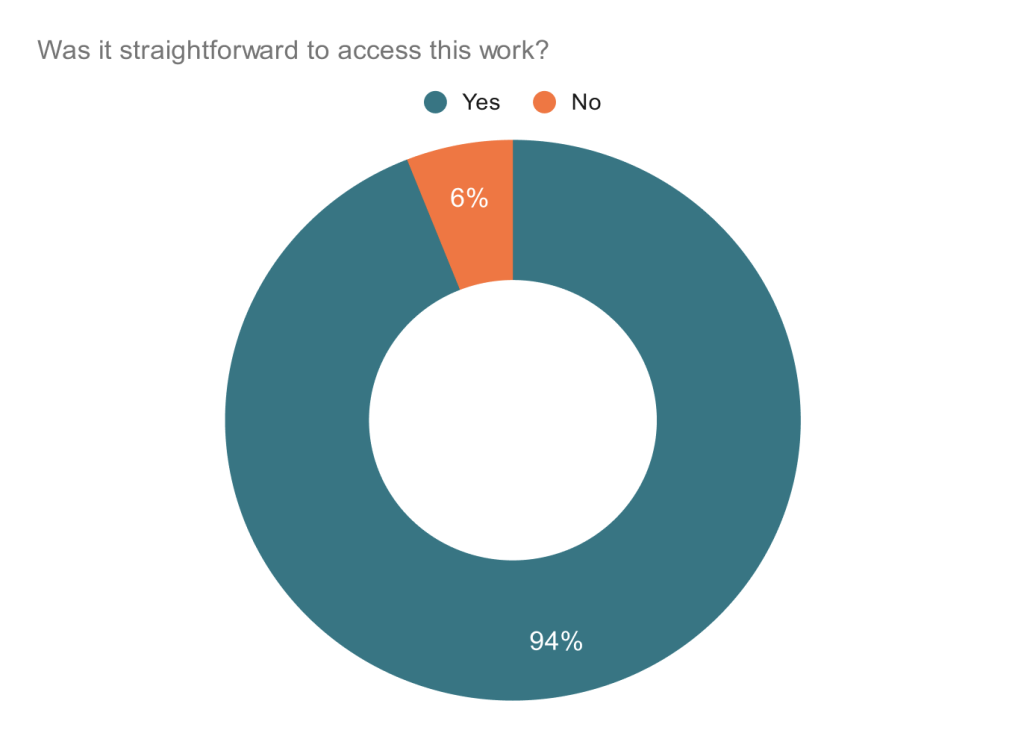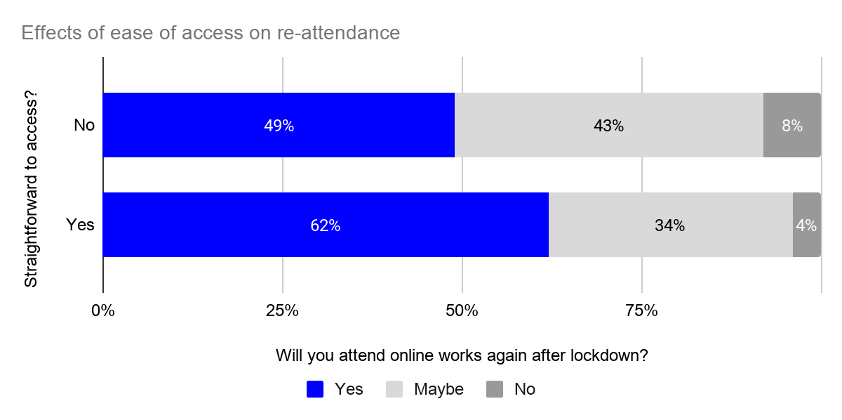Following on from our previous blogpost ‘The importance of a shared experience when delivering online works‘ this post focusses on the second insight we gained from the analysis of data from the online works survey.
The unique access barriers for cultural works online
Accessibility is very important for arts and cultural works for obvious reasons. Organisations spend resources focussing on improving the accessibility of their in-person works and removing barriers that might be unfairly blocking certain groups of people – even if in relative terms the number of people affected might be small.
Yet most people visiting in-person events do so with almost absolute confidence that they will successfully access the work. It is very unlikely (although possible) that someone misses the work entirely simply because they could not find or get to their seat. However, this is not the case for works online where many people are new to the medium. It may be a different method used to access the work each time, or technology barriers are in the way that makes it impossible to access at all.
When asked, 6% of respondents said that the work was not easy to access. As 4,578 people answered this question, that means 275 people had access issues just from the sample that we have access to.

n=4578
The freely written comments of the 6% who answered ’No’ to the above question are insightful as they make the reader aware of the level of frustration faced by audiences who struggle to access the work, and make it apparent that the experience of ‘finding your seat’ for online works is varied, unfamiliar and challenging.
“Needed help from someone else. Could watch pre show stuff ok but not the actual show. I thought just clicking the link would be all that was needed but I had to sign up for some account to access the show.”
“Easy to buy tickets. Difficult to access once paid for. I enlisted the aid of the box office.”
“I am so sad that for some reason using Amazon Silk browser as suggested on your site, meant the show continuously buffered and often froze. I missed half the show and couldn’t invest in the action. I contacted your help chat, they were helpful, but sadly their suggestions to try another platform after logging off did not work – I was disallowed to login elsewhere.”
“I struggled to get it on my smart TVs so I had to watch it on my tablet. This might put me off in the future”
“It should have been possible to chromecast the transmission from a laptop. It wasn’t. We spent an hour trying, including contact with the Chat Helpline, and then gave up. We couldn’t even watch directly on the laptop as it was barely audible. We are long-standing and loyal supporters of (NPO redacted) and we were very disappointed.”
If we look at the effects of the access difficulties on the likelihood for re-attendance, we see what looks like a relatively small effect. 62% of those who found it straightforward to access say they will attend again after lockdown, whereas 49% of those who did not find it straightforward will re-attend. This is a smaller effect than you might expect, given the comments above.

n: No=253, Yes=4086
However, if we again review some of the comments from these people it becomes clear that they would only re-attend on the assumption that access would be solved next time around, as their experience was clearly negative.
For example, this person said that they would re-attend after lockdown despite completely failing to access the work:
“After purchasing a ticket some while ago, I found it very non user friendly to get to the online performance. Eventually, I purchased another ticket so as not to miss the performance. I am now due a refund. Then, the online performance kept dropping out. So, in the end, I gave up.”
They are saying yes to re-attendance on the assumption that they will not have access issues.
Conclusion
In the previous blogpost, ‘The importance of a shared experience when delivering online works‘, we talked about movie streaming services, and again those services are an appropriate comparison here.
Imagine that instead of having a single, centralised platform with thousands of shows and movies (e.g. Netflix), you had to wrestle with a different website, with a different ticketing system, using different technologies… It is easy to imagine that this might be a painful experience and limit people’s access and enjoyment of the work on offer.
In order to cultivate a repeat audience for online cultural works, we should aim for consistent solutions to delivering online works. To enable organisations who have limited resources to solve the access issues, some centralised or standardised approaches for offering online works may be required.
I pose the question, ‘Is it possible to create the Netflix of arts and cultural performance?’
Image credit: Photo by Markus Spiske on Unsplash